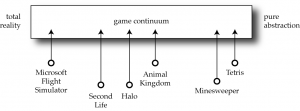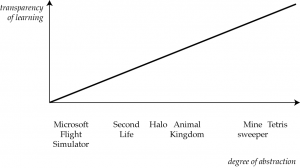I spend a lot of my time discussing the efficacy of games for learning. I think all games offer us something for the real world but the crucial aspect for transferability is representation of the game world. I believe that we can map games on a scale ranging from reality to abstraction; I call this the game continuum.
Games that are an exact or close map to reality appear at one end of the spectrum while games that offer non-representational environments sit at the other. For example, Microsoft designs its Flight Simulator to be as close to flying a real Cessna as possible. Naturally, there are limits to the experience that can be delivered through a computer, real travel and movement being the obvious examples, however, the simulation aims to portray an exact likeness of the cockpit instrumentation and flight characteristics of the aeroplanes it models. As with real flying the potentially activity is limitless in its diversity. That is to say that even though the behaviour and characteristics of aeroplanes are constrained by tightly defined physical laws, there are so many possible combinations of environment and behaviour that every ‘flying’ experience is unique.
The flight sim representation of reality is so comprehensive and so accurately modelled that there are apocryphal tales of players managing to transfer their flying skills directly from the simulator straight to genuine aircraft. This transfer of understanding is a critically important point for game based learning: games that represent reality closely allow players to move between domains relatively easily – the learning is deliberately explicit. At the same time these ‘realistic fantasies’ appeal to a fairly niche market because, in all honesty, most real life activity is pretty dull and adventurous pursuits like flying require astonishing attention to detail and perseverance.
At the other end of the scale, abstract games such as Tetris exist without any obvious relationship to real life. Although, by definition, games adhere to defined rules, non-representational games are characterised by tasks and relationships that do not relate obviously to reality or any concrete experience. In spite of the fact that within a game like Tetris, the blocks appear to fall under the influence of gravity, it is a variable force – the speed increases arbitrarily with the level of difficulty. And the task itself, rotating clusters of squares to fill gaps, bears no obvious relation to any everyday activity. Like jigsaw puzzles, Tetris is an exercise in pure maths – a playful test of rotation and translation, and a measure of executive function, our ability to plan and organise.
Although some form of skills development occurs in all game play, as abstraction increases so too does the transparency of learning. That is to say, it is obvious to a user of a flight simulation that the activity on screen represents some real-life scenario; for a Tetris player any learning from the game is virtually transparent, invisible and irrelevant to anything other than the game itself. The learning involved in abstract games, beyond improvement in gameplay, is almost always totally obscure – it almost always requires some intervention, a teacher or the requirement to describe the activity to highlight the concepts.
The need for intervention is an aspect of games-based learning that many seem to ignore, instead believing that merely playing the game is an educational experience than can magically seep into real life. Good teachers can always use stimulus materials (like games, apparently relevant or otherwise) as a catalyst for learning. The challenge for learning game designers is to build that scaffolding into the play in such a a way that it enables users to see value outside the game.
 Play with Learning is a creative media service led by Carlton Reeve.
Play with Learning is a creative media service led by Carlton Reeve.

Hello, I like your website. This is a nice site and I wanted to post a comment to let you know, great job!
Thanks,
Berthes
it was very interesting to read playwithlearning.com
I want to quote your post in my blog. It can?
And you et an account on Twitter?
Hi Nikolay
I’d be flattered if you quoted my blog – thank you for the compliment!
Follow me on Twitter with @carlton
Pingback: Where games meet learning | Play with Learning